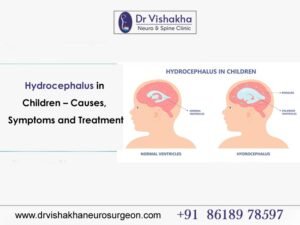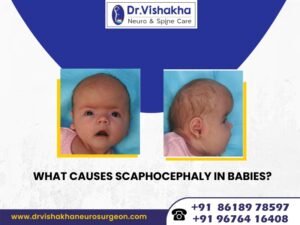Craniosynostosis surgery, as explained by Dr Vishakha Basavraj Karpe, who is the best paediatric neurosurgeon, is a procedure performed to correct a condition in which one or more of the sutures in a baby’s skull closes prematurely, affecting the shape of the head and potentially leading to increased pressure on the brain. The surgery involves reshaping the skull by removing the fused suture and allowing for normal growth of the skull and brain.
There are different types of surgeries depending on the type and severity of craniosynostosis. The most common approach is cranioplasty, where the skull pieces are repositioned or reshaped. This surgery is usually done in infancy, often between three and twelve months old, to take advantage of the brain’s rapid growth during this period.
Post-surgery, children typically need monitoring to ensure proper healing and development. The overall goal of craniosynostosis surgery is to improve the appearance of the head, relieve any pressure on the brain, and promote normal cognitive development.
Understanding Craniosynostosis in a nutshell
Craniosynostosis is a condition that occurs when one or more of the sutures in a baby’s skull fuse prematurely before the brain has fully formed. The skull is made up of several bones that are joined together by flexible joints called sutures. These sutures allow for the growth of the skull as the brain grows.
When a suture fuses early, it can restrict the skull’s growth in that area and cause the head to develop an abnormal shape.
Common types of craniosynostosis
- Sagittal synostosis: The most common type, where the sagittal suture (running from the front to the back of the skull) fuses, leading to a long, narrow head shape.
- Coronal synostosis: This occurs when one or both coronal sutures (running from ear to ear) fuse, resulting in a forehead that may appear flattened on one side and a brow that protrudes on that side.
- Metopic synostosis: The metopic suture, which runs from the top of the head down to the nose, fuses too early, causing a triangular forehead shape.
- Lambdoid synostosis: This involves the fusion of the lambdoid suture at the back of the skull, which can lead to asymmetrical head shapes.
Symptoms can vary, but parents may notice a misshapen head or unusual forehead shape. In some cases, craniosynostosis can be detected through physical examination or imaging studies such as X-rays or CT scans.
Treatment typically involves surgery to correct the shape of the skull and allow for normal brain growth. The timing and approach of the surgery depend on the specific type of craniosynostosis and the age of the child. Early intervention is generally preferred to minimize complications and support normal brain development.
Craniosynostosis surgery at 5 years old

Dr Vishakha Basavraj Karpe – the best paediatric neurosurgeon, says that Craniosynostosis surgery for a 5-year-old is similar in purpose to the surgery performed on an infant. Still, it may be approached differently depending on the child’s age and the severity of the condition.
Craniosynostosis Surgical procedure
During the surgery, Dr Vishakha Basavraj Karpe may either remove the fused sutures completely or reshape the skull bones to achieve a more normal contour. The operation usually takes several hours, and the child may need to stay in the hospital for a few days for monitoring and recovery.
After the surgery, parents can expect some swelling and bruising around the head, but this gradually improves. Follow-up appointments are important to ensure everything is healing well and to monitor growth and development. Overall, the goal of craniosynostosis surgery at this age is to enhance both the appearance of the head and the health of the brain.
Types of Craniosynostosis Surgery
- Open Cranial Vault Reconstruction: This is the most common surgical approach. The surgeon makes an incision in the scalp to access the skull. They then carefully remove the fused suture and reshape the skull by repositioning the bones. This approach provides comprehensive access and typically results in a more significant reshaping of the skull.
- Endoscopic Surgery: In some cases, especially for milder forms of craniosynostosis, an endoscopic approach may be used. This involves smaller incisions and the use of a camera to guide the procedure. This method is less invasive, may require a shorter recovery time, and often utilizes helmet therapy post-surgery to shape the skull as it grows.
Surgery is generally performed within the first year of life, although the exact timing can depend on the type of craniosynostosis and the individual child’s circumstances. Early intervention is crucial to enable proper brain growth and to avoid potential complications as the child develops.
Recovery from Craniosynostosis surgery
Post-surgery, the child may spend a few days in the hospital for monitoring. Recovery at home involves managing pain, keeping the surgical site clean, and following up with the healthcare team. Parents are often guided on how to care for their child, including activities to avoid during the healing process.
Follow-up Care for Craniosynostosis surgery
Regular follow-up appointments are essential to monitor the child’s head shape and development. In some cases, additional procedures may be required later on, depending on individual growth and needs.
Overall, while craniosynostosis surgery is a significant procedure, it has a high success rate and can lead to positive outcomes, allowing for healthy development and improved appearance.

A guide to age-wise craniosynostosis surgery
Craniosynostosis surgery timing can vary depending on the type of craniosynostosis, the specific characteristics of a child’s condition, and the recommendations of healthcare professionals. Here’s a general guideline to understand how surgery may be approached at different ages:
Infancy (0-6 months)
Most surgeries are performed between 3 to 12 months of age. This is when the skull bones are still soft, allowing for easier reshaping. Early intervention can help prevent pressure on the brain and promote normal brain development. The impact on the head shape is also more easily corrected at this stage.
Toddler Years (1-3 years)
If craniosynostosis is diagnosed later, surgery can still be performed, but it may be more complex.The child’s cognitive and physical development will be closely monitored, as delays may occur if the condition is left untreated. While the surgery can still provide significant benefits at this age, the healing process may be longer, and there may be a higher chance of complications compared to surgery performed in infancy.
Preschool Age (3-5 years)
If craniosynostosis has not yet been addressed, surgery may still be necessary. However, the type of surgery may differ, and the procedure might be more extensive.
At this age, children may understand more about the procedure, so it’s important to prepare them for what to expect. Parents should consider discussing the surgery in simple, reassuring terms.Children may need additional time for recovery and may require supportive care during this period.
Early Childhood (5+ years)
While it’s best to address craniosynostosis earlier, surgery can still be performed in older children, especially if there are significant concerns about head shape or brain growth.Surgery may involve more detailed planning and consideration for the child’s existing cranial shape and brain development. After surgery, long-term follow-up is essential to monitor development and address any issues that may arise.
Overall, early identification and intervention are key. Each child’s situation is unique, so consultation with a pediatric neurosurgeon such as Dr Vishakha Basavraj Karpe is essential to determine the best timing and approach for craniosynostosis surgery. Regular follow-up and monitoring will help ensure the best outcomes as the child grows.
About Dr Vishakha :
Dr Vishakha Basavraj Karpe is a highly skilled senior consultant at Rainbow Children’s Hospital in Banjara Hills and Hydernagar Hyderabad. She is known for her comprehensive care approach and is one of the few dedicated leading paediatric neurosurgeons in the city and India with over ten years of extensive experience in pediatric neurosurgery. Her expertise includes treating hydrocephalus, spinal dysraphism, craniosynostosis, paediatric brain infections, brain and spine tumours and stroke surgery.
She has a special interest in craniosynostosis surgery, which is done only in very few centres in India.
Proficiency of Dr Vishakha:
-
- Hydrocephalus (increased fluid in the brain): The procedure involves an endoscopic third ventriculostomy and CSF diversion (VP shunt) to treat complex hydrocephalus.
- Craniosynostosis (abnormal head shape due to untimely cranial sutures fusion) surgeries: Helmet therapy is a technique that is used in both endoscopic and open surgery.
- Spinal dysraphisms(Spina Bifida)(spinal abnormalities present by birth) surgical repair
- Encepahaocles repair surgery.
-
- Vascular conditions and stroke surgeries: revascularization surgeries for moya moya disease.
- Pediatric brain and spine tumour surgeries.
-
- Pediatric brain and spine infection surgeries: Endoscopic and open surgeries for brain and spine infections.
- Pediatric traumatic brain and spinal injury.
- Antenatal counselling for congenital fatal neurosurgical conditions.





